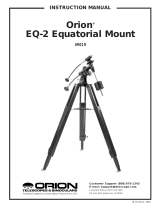
2
Table of Contents
INTRODUCTION .......................................................................................................................... 3
ASSEMBLY ................................................................................................................................... 6
Setting up the Tripod .................................................................................................................. 6
Attaching the Equatorial Mount.................................................................................................. 7
Installing the Counterweight Bar & Counterweights.................................................................. 7
Attaching the Slow Motion Cables............................................................................................. 8
Attaching the Telescope Tube to the Mount............................................................................... 8
Installing the Diagonal & Eyepiece (refractor)........................................................................... 9
Installing the Eyepiece on the Newtonians................................................................................. 9
Moving the Telescope Manually .............................................................................................. 10
Balancing the Mount in R.A. .................................................................................................... 10
Balancing the Mount in Dec. .................................................................................................... 10
Adjusting the Equatorial Mount................................................................................................ 11
Adjusting the Mount in Altitude............................................................................................... 11
TELESCOPE BASICS ................................................................................................................. 12
Image Orientation ..................................................................................................................... 13
Focusing.................................................................................................................................... 13
Aligning the Finderscope.......................................................................................................... 13
Calculating Magnification ........................................................................................................ 14
Determining Field of View ....................................................................................................... 15
General Observing Hints........................................................................................................... 15
ASTRONOMY BASICS .............................................................................................................. 16
The Celestial Coordinate System.............................................................................................. 16
Motion of the Stars.................................................................................................................... 16
Polar Alignment with Latitude Scale........................................................................................ 17
Pointing at Polaris..................................................................................................................... 18
Finding the North Celestial Pole............................................................................................... 18
Polar Alignment in the Southern Hemisphere .......................................................................... 19
Aligning the Setting Circles...................................................................................................... 21
Motor Drive .............................................................................................................................. 22
CELESTIAL OBSERVING ......................................................................................................... 23
Observing the Moon ................................................................................................................. 23
Observing the Planets ............................................................................................................... 23
Observing the Sun..................................................................................................................... 23
Observing Deep-Sky Objects.................................................................................................... 24
Seeing Conditions ..................................................................................................................... 24
ASTROPHOTOGRAPHY............................................................................................................ 25
Short Exposure Prime Focus Photography ............................................................................... 25
Piggyback Photography ............................................................................................................ 25
Planetary & Lunar Photography with Special Imagers............................................................. 25
CCD Imaging for Deep Sky Objects ........................................................................................ 25
Terrestrial Photography ............................................................................................................ 25
TELESCOPE MAINTENANCE.................................................................................................. 26
Care and Cleaning of the Optics ............................................................................................... 26
Collimation of a Newtonian...................................................................................................... 26
OPTIONAL ACCESSORIES ..................................................................................................... 29
AstroMaster Specifications........................................................................................................... 30





















